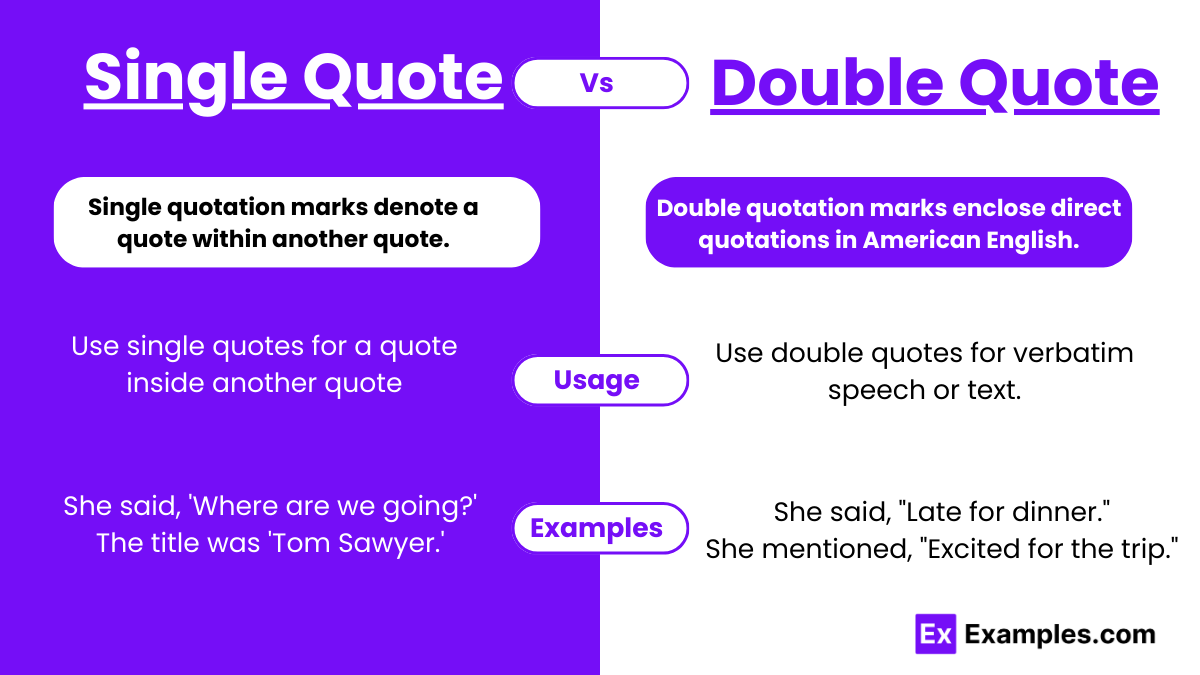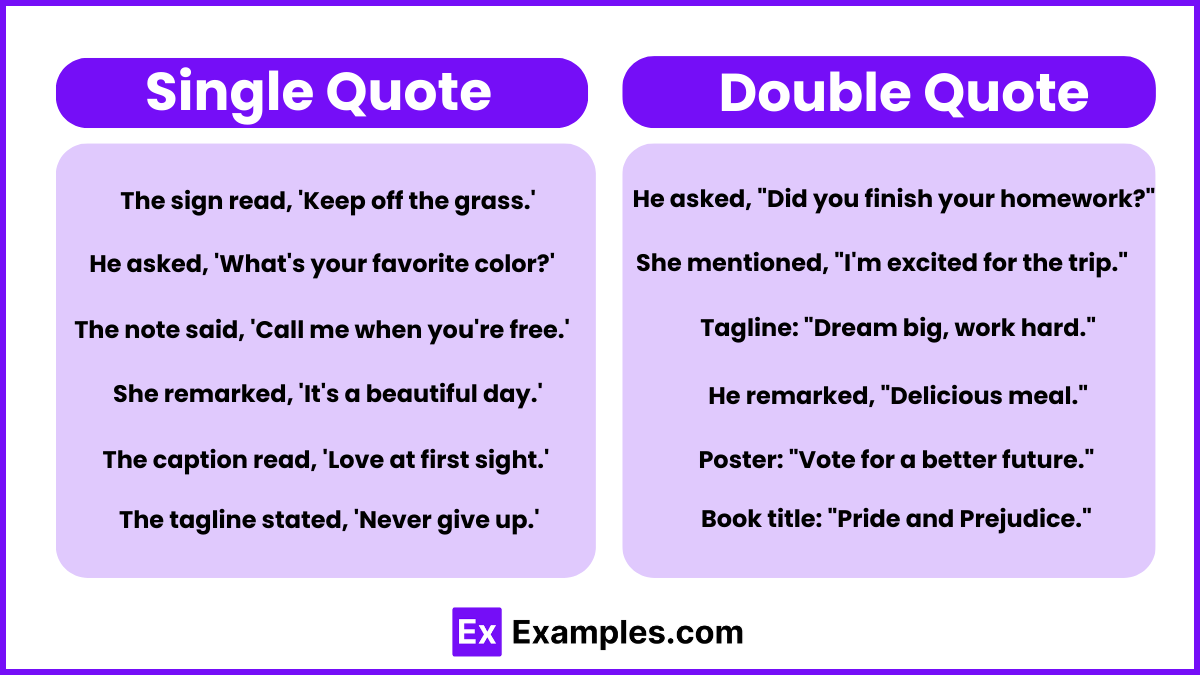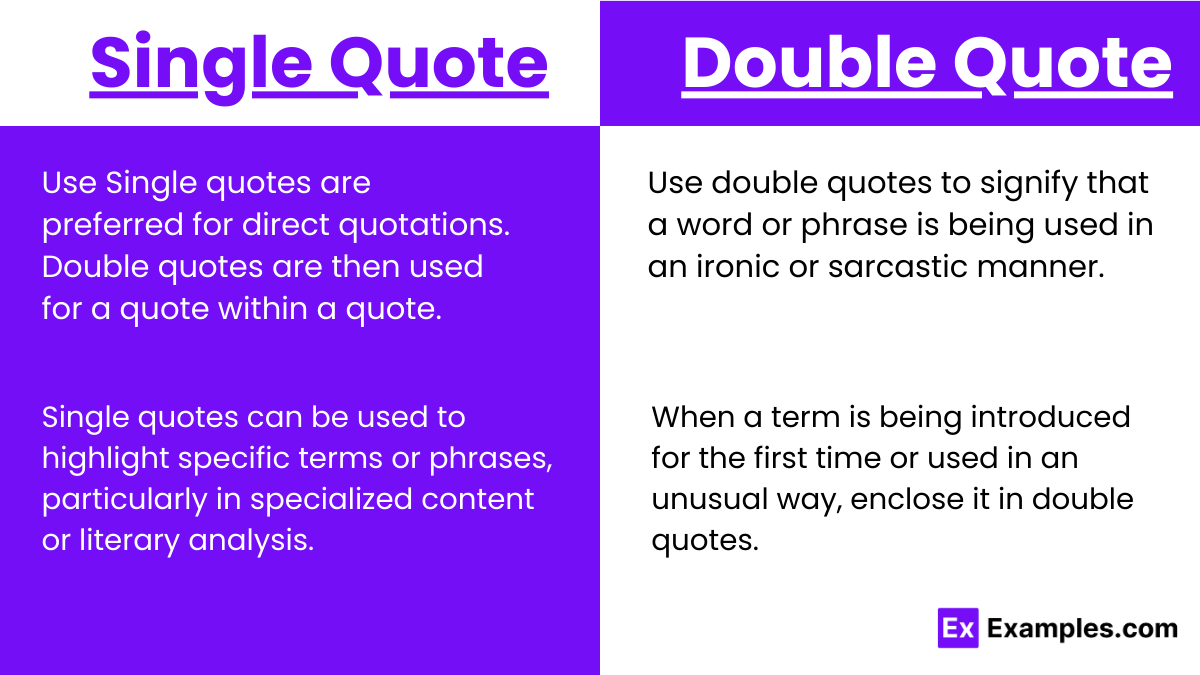Single vs Double Quotes – Examples, Differences, Usage
In English landscape of punctuation, particularly when it comes to the use of single (‘ ‘) and double (” “) quotation marks, is a cornerstone of proficient writing. These punctuation marks not only encapsulate direct speech and titles but also serve to highlight elements like irony, unfamiliar terms, and nested quotations. For students delving into the intricacies of English grammar, understanding the appropriate contexts for these symbols becomes essential. The rules governing their usage illuminate the path to clarity and precision in both academic and creative writing.
The distinction between single (‘ ‘) and double (” “) quotation marks extends beyond mere preference, embedding itself in the conventions of American English. While double quotation marks are the go-to for direct quotes and titles of various compositions, single marks find their use in more specialized contexts such as quotes within quotes. This article sets out to demystify these conventions, offering a clear guide on when and how to use each type of quotation mark. Through exploring these rules, students can enhance their writing skills, ensuring their work resonates with accuracy and professionalism in any setting.
Single and Double Quotes – Meaning
Single Quotes (‘ ‘): Single quotation marks (‘ ‘) are traditionally used to denote a quote within another quote, serving as a secondary level of quotation in writing. For instance, when a character in a story is quoting someone else, the inner quotation is enclosed in single quotes. Beyond this primary function, single quotes are sometimes employed to highlight specific terms, slang, or to denote titles in certain contexts. Their use varies across different English-speaking regions, with British English often using them where American English would opt for double quotes.
Double Quotes (” “): Double quotation marks (” “) are the standard choice for enclosing direct quotations in American English. They are used to signify someone’s spoken or written words exactly as they were originally stated or to denote titles of larger works like books, movies, and songs. Double quotes can also be used to convey irony or sarcasm, or to introduce a term or phrase that may be unfamiliar to the reader. In the landscape of punctuation, double quotes play a crucial role in clearly distinguishing a speaker’s dialogue or a direct citation within the text.
Summary
Single quotation marks (‘ ‘) are primarily utilized to encapsulate a quotation nestled within another quote, exemplifying a layering of voices or references. A classic instance of this usage is evident in statements like, “Attending the university became my goal after hearing the president declare, ‘Your success is our commitment.'” While often deemed superfluous, single quotes find a niche application in headlines featuring quotes or titles, adding a layer of emphasis or clarity.Conversely, double quotation marks (” “) are the go-to for encapsulating direct speech, titles of major works such as novels, films, music, lectures, and television programs. Beyond their traditional role, they serve to underscore irony or sarcasm and to flag new, unusual, or coined terms and nicknames, guiding the reader through varied nuances of communication.
Difference Between Single and Double Quotes
Single and double quotation marks are pivotal elements of punctuation in English, each serving distinct purposes that enrich the clarity and meaning of written communication. Understanding the differences between single (‘ ‘) and double (” “) quotes is crucial for accurate and effective writing. These differences not only adhere to grammatical norms but also guide the reader through the subtleties of dialogue, citation, and emphasis. Below is a table outlining 10 key distinctions to help demystify their usage:
| Aspect | Single Quotes (‘ ‘) | Double Quotes (” “) |
|---|---|---|
| Primary Use | Enclose quotes within other quotes. | Enclose direct quotations and dialogues. |
| Titles | Used for titles within quotes. | Used for titles of books, movies, songs, etc. |
| Emphasis | Less commonly used for emphasis. | Often used to indicate irony, sarcasm, or special terms. |
| Dialogue | Rarely used for dialogue. | Standard for indicating spoken words. |
| Regional Usage | Preferred in British English for direct quotes. | Preferred in American English for direct quotes. |
| Nested Quotes | Outer layer in British English; inner layer in American English. | Inner layer in British English; outer layer in American English. |
| Introducing Terms | Occasionally used to introduce a term or nickname. | Commonly used to introduce unfamiliar or coined terms. |
| Irony or Sarcasm | Less commonly used. | Frequently used to denote irony or sarcasm. |
| Headlines | Sometimes used in headlines for quotes or titles. | Less common in headlines, unless denoting speech or titles. |
| Technical Writing | May be used for specific terminology or citations within a quote. | Used for quotations, references, and examples in text. |
This table highlights the nuanced roles single and double quotation marks play in enhancing the precision and depth of written language, each contributing to the rich tapestry of English communication.
Examples of Single and Double Quotes
Examples of Single Quotes (‘ ‘)
- Sarah said, ‘I can’t believe how quickly time flies.’
- In the midst of his speech, he quoted Kennedy, saying, ‘Ask not what your country can do for you—ask what you can do for your country.’
- ‘Eureka!’ exclaimed the scientist when she made the groundbreaking discovery.
- The word ‘serendipity’ means finding something good without looking for it.
- In her essay, Jane argues that ‘the personal is political,’ highlighting the interconnection of private experiences and public issues.
Examples of Double Quotes (” “)
- “Where there is love, there is life,” Mahatma Gandhi once said.
- The teacher asked, “Have you completed your homework?”
- “The Great Gatsby” is one of the most celebrated novels in American literature.
- “I thought the movie was overrated,” he admitted, “but the soundtrack was impressive.”
- In the documentary, the narrator begins with, “At the dawn of the 20th century, the world was changing rapidly.”
When to Use Single and Double Quotes
Understanding when to use single (‘ ‘) and double (” “) quotes is essential for clear and effective written communication. Here’s a guideline to help you navigate their usage:
When to Use Single Quotes (‘ ‘)
- Quotes Within Quotes: Use single quotes for a quote inside another quote. Example: He said, “I heard her say ‘Never again’ after the incident.”
- British English Preference: In British English, single quotes are preferred for direct quotations. Double quotes are then used for a quote within a quote.
- Highlighting Specific Terms: Although less common, single quotes can be used to highlight specific terms or phrases, particularly in specialized content or literary analysis.
- Headlines or Titles Within Quotes: Single quotes are sometimes used in headlines or within double-quoted material to denote titles of works or emphasize particular words.
When to Use Double Quotes (” “)
- Direct Quotations: Use double quotes for verbatim speech or text. Example: She said, “I’ll meet you there.”
- Titles: In American English, double quotes are used for titles of short works, like articles, chapters, or songs. Example: “Thriller” is my favorite song.
- Indicating Irony or Sarcasm: Use double quotes to signify that a word or phrase is being used in an ironic or sarcastic manner. Example: He is so “helpful” around the house.
- Introducing Unfamiliar Terms: When a term is being introduced for the first time or used in an unusual way, enclose it in double quotes. Example: The term “quantum entanglement” refers to a physical phenomenon.
Quotation marks in American English and British English
Quotation marks serve as an essential punctuation tool in both American and British English, but their usage conventions differ slightly between the two.
American English:
- Single Quotes for Quotes Within Quotes: When a quote occurs within another quote, single quotation marks (‘ ‘) are used for the inner quotation. Example: “Did he really say ‘I’ll be there’?” she asked.
- Double Quotes for Direct Speech: American English typically uses double quotation marks (” “) for direct speech and quotations. For example: “I’ll see you tomorrow,” she said.
- Periods and Commas Inside Quotes: In American English, periods and commas are placed inside quotation marks, regardless of whether they are part of the quoted material. Example: “She was late,” he noted.
British English:
- Single Quotes for Direct Speech: British English commonly uses single quotation marks (‘ ‘) for direct speech and quotations. For example: ‘I’ll see you tomorrow,’ she said.
- Double Quotes for Quotes Within Quotes: When there is a quote within another quote, double quotation marks (” “) are used for the inner quotation. Example: ‘Did he really say “I’ll be there”?’ she asked.
- Periods and Commas Outside Quotes: In British English, periods and commas are typically placed outside the quotation marks, unless they are part of the quoted material. Example: ‘She was late’, he noted.
FAQs
What Is the Purpose of a Single Quotation Mark?
Single quotation marks (‘ ‘) are used primarily to indicate a quote within another quote, highlight specific terms or phrases, and sometimes denote titles in headlines. They play a crucial role in maintaining clarity and structure in written communication.
What Are the First Two Rules for Quotation Marks?
- Use quotation marks to enclose direct speech or quotations.
- Place punctuation inside the quotation marks for a complete quoted sentence; outside for a quoted phrase.
Should I Single or Double Quote Strings?
In writing, use double quotes for direct quotations and dialogue. In programming, the choice between single (‘ ‘) or double (” “) quote strings depends on the language’s syntax and the need to include variables or escape characters.
When Not to Use Single Quotation Marks?
Avoid single quotation marks when directly quoting someone or something in American English. They should not be used in place of double quotes for direct speech, except as quotes within quotes





